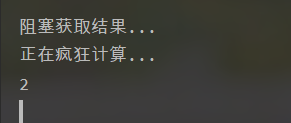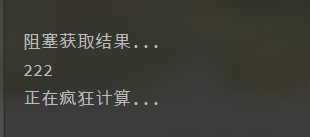文章目录
了解CompletableFuture

Doug Lea,并发包的作者…就不多说了,敬佩
CompletableFuture实现了两个接口,一个是Future.一个是CompletionStage;future算是一种模式,对结果异步结果的封装,相当于异步结果,而CompletionStage相当于完成阶段,多个CompletionStage可以以流水线的方式组合起来,共同完成任务.
初始化CompletableFuture
CompletableFuture有五个静态方法,

这个返回已经计算好结果的,封装为CompletableFuture返回(我在想,既然已经计算好了,那我还要使用CompletableFuture干啥?我使用CompletableFuture就是为了异步处理结果数据,异步分为获取结果异步,和异步处理结果,这两个地方最耗时,我感觉这个用的不是很多):
- public static CompletableFuture completedFuture(U value)
而其他四个静态方法用来为一段异步执行的代码创建CompletableFuture对象:
- public static CompletableFuture runAsync(Runnable runnable)
- public static CompletableFuture runAsync(Runnable runnable, Executor executor)
- public static CompletableFuture supplyAsync(Supplier supplier)
- public static CompletableFuture supplyAsync(Supplier supplier, Executor executor)
根据返回结果和请求参数我们就知道,一个是又返回结果的,一个是void的,一个是传线程池的,一个是没有传线程池的,这个具体传不传还是需要看业务,一般如果执行的比较多,就创个线程池去处理,没有多少访问的使用默认的线程池也没事,只是出了问题不好定位…具体看情况.
常用方法
获取返回结果:

get()方法肯定都用过,阻塞获取返回结果,下面就是加上超时时间,getNow(T)就是立马获取结果,如果还没有算出来结果,那就直接返回我传进去的默认值,用的也不多
代码测试:
@Test
public void test1() throws Exception {
CompletableFuture<Integer> objectCompletableFuture = CompletableFuture.supplyAsync(() -> {
System.out.println("正在疯狂计算...");
try {
TimeUnit.SECONDS.sleep(3);
} catch (InterruptedException e) {
e.printStackTrace();
}
return 1 + 1;
}
);
// System.out.println("阻塞获取结果...");
// Integer integer = objectCompletableFuture.get();
// System.out.println(integer);
System.out.println("阻塞获取结果...");
Integer integer = objectCompletableFuture.getNow(222);
System.out.println(integer);
}
这是get();会阻塞

getNow()不会阻塞.

异步执行结果(相当于设置处理器,执行完成,自动执行处理器,异步):
方法如下:
- public CompletableFuture whenComplete(BiConsumer<? super T,? super Throwable> action)
- public CompletableFuture whenCompleteAsync(BiConsumer<? super T,? super Throwable> action)
- public CompletableFuture whenCompleteAsync(BiConsumer<? super T,? super Throwable> action, Executor executor)
- public CompletableFuture exceptionally(Function<Throwable,? extends T> fn)
这些方法带着Async就是表示异步执行,表示可能会有其他线程来执行,如果不带Async,表示由刚刚返回结果的线程执行,如果传了线程池,则会有线程池里面其他线程来执行,也有可能是同一条线程,(建议反复阅读)
参数的话,第一个是结果了,第二个是异常,直接使用lambda表达式表示即可,返回参数都是CompletableFuture,跟原来的CompletableFuture不是同一个对象,但是结果跟异常是一样的我用代码写出来了,exceptionally方法用的也不多,应该是如果出现了异常,重新进行计算或者直接返回默认值把.
代码:
public static void main(String[] args) {
CountDownLatch countDownLatch = new CountDownLatch(1);
CompletableFuture<Integer> integerCompletableFuture = new CompletableFuture<>();
CompletableFuture<Integer> integerCompletableFuture1 = CompletableFuture.completedFuture(3);
try {
Integer integer = integerCompletableFuture1.get();
System.out.println(1);
} catch (InterruptedException e) {
e.printStackTrace();
} catch (ExecutionException e) {
e.printStackTrace();
}
CompletableFuture<Integer> uCompletableFuture = CompletableFuture.supplyAsync(() -> {
try {
System.out.println("进行一连串操作....");
TimeUnit.SECONDS.sleep(3);
// int i = 3 / 0;
} catch (InterruptedException e) {
e.printStackTrace();
}
throw new NullPointerException("aa");
// return 3;
});
System.out.println(integerCompletableFuture == uCompletableFuture);
System.out.println("设置whenComplete方法....");
CompletableFuture<Integer> integerCompletableFuture2 = uCompletableFuture.whenComplete((x, y) -> {
System.out.println("执行完成!" + x);
System.out.println("执行完成!" + y);
throw new NullPointerException("222");
});
integerCompletableFuture2.whenComplete((x, y) -> {
System.out.println("执行完成!" + x);
System.out.println("执行完成!" + y);
countDownLatch.countDown();
});
System.out.println("返回的integerCompletableFuture2是否相同" + (integerCompletableFuture2 == uCompletableFuture));
try {
countDownLatch.await();
} catch (InterruptedException e) {
e.printStackTrace();
}
}
执行结果:两个异常是相同的,但是类不是同一个类…

串行执行,依赖上个任务的结果进行操作
对应的方法:
public <U> CompletableFuture<U> thenApply(
Function<? super T,? extends U> fn) {
return uniApplyStage(null, fn);
}
public <U> CompletableFuture<U> thenApplyAsync(
Function<? super T,? extends U> fn) {
return uniApplyStage(asyncPool, fn);
}
public <U> CompletableFuture<U> thenApplyAsync(
Function<? super T,? extends U> fn, Executor executor) {
return uniApplyStage(screenExecutor(executor), fn);
}
使用测试:
@Test
public void test1() throws Exception {
CompletableFuture<Integer> future1 = CompletableFuture.supplyAsync(() -> {
System.out.println(Thread.currentThread().getName()+"进行一连串操作1....");
try {
TimeUnit.SECONDS.sleep(3);
} catch (InterruptedException e) {
e.printStackTrace();
}
return 1;
}).thenApplyAsync(x -> {
try {
System.out.println(Thread.currentThread().getName()+"进行一连串操作2....");
TimeUnit.SECONDS.sleep(3);
} catch (InterruptedException e) {
e.printStackTrace();
}
return x + 1;
});
CompletableFuture<Integer> future = future1.thenApplyAsync(x -> {
try {
System.out.println(Thread.currentThread().getName()+"进行一连串操作3....");
TimeUnit.SECONDS.sleep(3);
} catch (InterruptedException e) {
e.printStackTrace();
}
return x + 1;
});
Integer integer = future.get();
System.out.println(integer);
}
串行执行,进行最后计算操作,没有返回值
源码:
public CompletableFuture<Void> thenAccept(Consumer<? super T> action) {
return uniAcceptStage(null, action);
}
public CompletableFuture<Void> thenAcceptAsync(Consumer<? super T> action) {
return uniAcceptStage(asyncPool, action);
}
public CompletableFuture<Void> thenAcceptAsync(Consumer<? super T> action,
Executor executor) {
return uniAcceptStage(screenExecutor(executor), action);
}
public CompletableFuture<Void> thenRun(Runnable action) {
return uniRunStage(null, action);
}
public CompletableFuture<Void> thenRunAsync(Runnable action) {
return uniRunStage(asyncPool, action);
}
public CompletableFuture<Void> thenRunAsync(Runnable action,
Executor executor) {
return uniRunStage(screenExecutor(executor), action);
}
这几个方法相当于就是消耗,没有返回值:
测试:
@Test
public void test2() throws Exception {
CountDownLatch countDownLatch = new CountDownLatch(1);
CompletableFuture<Integer> future1 = CompletableFuture.supplyAsync(() -> {
System.out.println(Thread.currentThread().getName()+"进行一连串操作1....");
try {
TimeUnit.SECONDS.sleep(3);
} catch (InterruptedException e) {
e.printStackTrace();
}
return 1;
});
future1.thenRun(() -> {
System.out.println(Thread.currentThread().getName()+"进行一连串操作2....");
countDownLatch.countDown();
});
countDownLatch.await();
System.out.println(1);
}
这就是几个简单常用的CompletableFuture方法,已经使用的就这些,什么都执行完在执行啊,allOf,有一个执行完执行anyOf,这些暂时没碰到,但是具体使用都比较简单,因为没有具体使用,暂时就不进行记录了…